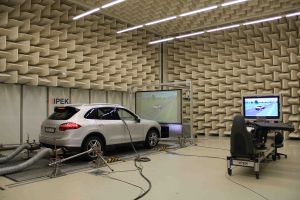The electric vehicle has not yet reached its final form for everyday use. Due to the variety of potential drive systems solutions, research institutes need a large set of expensive development tools. To use synergies and interconnect existing infrastructure facilities, five partners have now established a Network of Laboratories with funds of the state of Baden-Württemberg. It will allow for the coupling of physically separate components for studies in real time.
“This structured cooperation will improve competitiveness of research institutions in Baden-Württemberg,” Theresia Bauer, Baden-Württemberg Minister of Science, Research, and the Arts, emphasizes. “The Network of Laboratories will initiate innovative research projects and lay valuable foundations for electric mobility.”
“Solutions for future challenges of society cannot be designed by scientists all on their own,” Professor Thomas Hirth, Vice President for Innovation and International Affairs of KIT, is sure. “The Network will strengthen Baden-Württemberg as a location of research and innovation and initiate cooperation of innovative partners.
“Networking will result in a significant value added for research in Baden-Württemberg,” Professor Albert Albers of KIT, Spokesman of the XiL-BW-e Network, says. “The Network of Laboratories will establish an innovative development and validation process for electric drives of vehicles.”
On the way towards electric mobility, today’s standards for conventional drives cannot be transferred entirely or adapted to electric drives. For the implementation for today’s solutions for electric drives, hardly any networked development tools are available. The XiL-BW-e Network (framework-based XiL Network of Laboratories in Baden-Württemberg for electric mobility) will interconnect the state’s infrastructure facilities for research into electric mobility, as a result of which entirely new issues can be studied. The Network will allow for the interactive and dynamic use of physically separate test rigs. If necessary, research facilities will be backfitted and complemented. Joint interfaces, routines, and standard procedures will be developed.
The Network is financed by the Baden-Württemberg Ministry of Science, Research, and the Arts. The total budget is EUR 10.3 million. The partners of XiL-BW-e are the KIT and the universities of Stuttgart, Ulm, Aalen, and Esslingen. Cooperation is aimed at developing a concept for access to and use of all test rigs by partner institutions.
XiL: X-in-the-loop Approach
Complex interaction of mechanical, electric, and IT components in modern vehicles requires systematic and highly integrated development processes and development environments. At an early stage of product development, individual components have to be analyzed in a close-to-system environment in spite of lacking prototypes of the complete system. For this purpose, KIT has developed the X-in-the-loop approach (XiL). Validation of a physically existing gear system in interaction with the complete system is achieved by simulation-based coupling. Non-existant components and properties, such as engine behavior, the vehicle’s longitudinal dynamics, or tire properties, are represented by specific models and simulations using highly dynamic actuators. This simulation- and actuator-based approach allows for the flexible variation of parameters of the remaining system, an efficient analysis of the effects as well as for the exchange of data or parameters obtained at physically separate test rigs.
More about the KIT Mobility Systems Center: https://www.kit.edu/research/6720.php
Being “The University in the Helmholtz Association”, KIT creates and imparts knowledge for the society and the environment. It is the objective to make significant contributions to the global challenges in the fields of energy, mobility, and information. For this, about 10,000 employees cooperate in a broad range of disciplines in natural sciences, engineering sciences, economics, and the humanities and social sciences. KIT prepares its 22,800 students for responsible tasks in society, industry, and science by offering research-based study programs. Innovation efforts at KIT build a bridge between important scientific findings and their application for the benefit of society, economic prosperity, and the preservation of our natural basis of life. KIT is one of the German universities of excellence.

